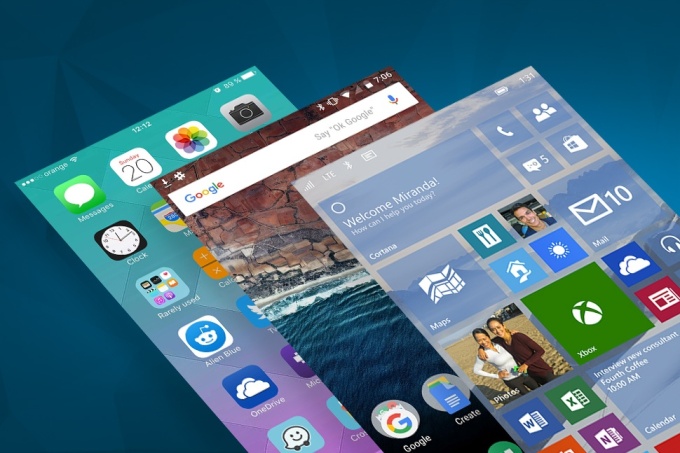
 Winner: Android
Winner: Android
Apple doesn’t make budget devices, and the latest iPhone is always among the most expensive handsets on the market, costing $200 with a two-year contract and $650 without. Last year’s iPhone 6 comes in at $100 less. The two year-old iPhone 5S is as close as Apple gets to budget at about $200 cheaper, but it’s still pricey.
Microsoft’s main hardware partner Nokia (which it now owns) was always good at producing quality hardware at relatively low prices. There are a wide range of older Windows Phones at varying price points, and finally a few that push the limit and rival Android and iOS on specs. Hardware manufacturers like Samsung, ZTE, LG, Lenovo, and Huawei were Windows Phone 8.1 partners, but it’s unclear who’ll be making Windows 10 Mobile handsets. We expect to see some cheap handsets in the near future, but Microsoft’s Lumia is likely to be the only flagship.
For sheer scale and variety nothing competes with Android. There’s a huge choice of low-cost handsets from a wide variety of different manufacturers and the platform has been deliberately optimized to run on low-end hardware. The fact that Android also leads the field in free apps makes it the natural choice for the budget-conscious. Chances are, if it’s a smartphone by HTC, Samsung, Sony, ZTE, Huawei, or LG, it’s running Android.
Interface
Led by Windows Phone, all three platforms have gravitated toward a minimalist, flat, fast, colorful user interface. The big difference is that many Android manufacturers have added their own user interfaces on top of stock Android, and so your mileage will vary. The basic structure with customizable home screens, an app drawer, and pull down notifications is standard, but there’s much more variation on Android than you’ll find on the other two platforms.
The Android Lollipop roll-out ushered in Google’s “Material Design,” which is a minimalist look with simple animations that’s intended to create a new continuity across the platform and in Google’s apps. It’s stylish and slick, and it runs on around 30 percent of Android devices, at the time of writing. The aesthetic hasn’t changed much in the latest Android 6.0 Marshmallow release, which brings a few subtle refinements, but you’ll need a new device or a Nexus right now to see it. App developers are still adjusting, and it will be a while before Android 6.0 Marshmallow represents a big share of Android users.
After a major redesign in iOS 7, Apple’s platform is bright and modern-feeling. The slick animations as you navigate around give a sense of depth, and it’s easy to understand. Under the new paint job, this is still the same iOS that came out in 2007. Still, many have complained that the new version of iOS is hard on the eyes. There are settings to turn off its offending animations. Apple has made further refinements in iOS 9, but the aesthetic remains largely unchanged.
Windows 10 Mobile is based on a grid of “Live Tiles,” which can be arranged and resized to suit the owner. It looks and acts much like Windows 10 PCs and tablets, and there’s a consistency here that Microsoft’s desktop and Xbox users will find familiar. Windows Mobile can still sometimes feel overly stylish and sluggish compared to iOS and Android. It is very customizable, though, and Windows 10 Mobile definitely feels slicker than previous versions. The latest Windows 10 Mobile hardware also supports Continuum, an intriguing feature that allows you to dock your phone, and switch to a desktop interface. You can throw it up on a big screen and use a mouse and keyboard with it, effectively making your phone a PC.
Apps
We can bump Windows Mobile straight out of the running here, because it trails way behind Android and iOS when it comes to overall app numbers and app quality.
- Android apps: 1.6 million
- iOS apps: 1.5 million
- Windows Mobile apps: ???
Traditionally, iOS has been a more lucrative platform for developers and easier to develop for, so there has been a tendency for new apps to appear there first, but that is changing as Android’s market share continues to grow. In the United States, iOS still leads the way, but developers elsewhere are increasingly targeting Android first. The Play Store still has a higher percentage of free apps than the App Store.
Android also benefits from the latest and greatest versions of Google’s apps, which are sorely missed on Windows Mobile. Microsoft has a “Universal Apps” plan for apps to run on multiple device types with common code, and it’s supposed to be easy to port Android or iOS apps over, but we’ll have to wait and see how developers respond. In terms of variety and quality, we have to give this one to iOS, but it’s a narrow win.
App store usability
None of the app stores offer an excellent user experience, and it can be tough to sift through the thousands of apps on offer to find what you really want. In terms of recommendations and curated charts, the Apple App Store maintains a slender lead over Google’s Play Store. Microsoft’s Windows Mobile store definitely lags behind in terms of usability and aesthetic
Alternative app stores and sideloading
It’s relatively easy to sideload apps (install them from your PC using a USB cable or alternate download method) on Android and there are a lot of alternative app stores beyond the Play Store, although sideloading can open you up to the risk of malware. Both Apple and Microsoft are opposed to third-party app stores and expect users to stick to their app stores. If you want a wider choice of apps and easy sideloading then your choice is obvious. Android is more open than its competitors and is more geek friendly.





